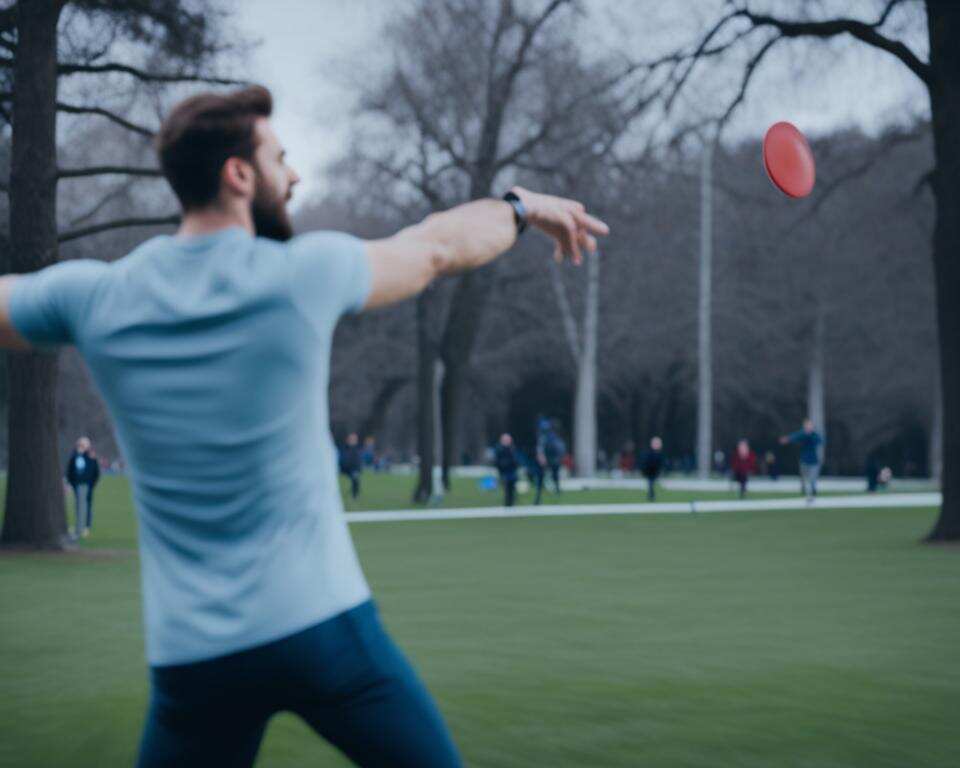Are you looking for a fun and engaging way to stay active and burn calories? Look no further than disc golf! This growing sport offers more benefits than meets the eye. In fact, the calorie-burning potential of disc golf might surprise you.
Disc golf, also known as Frisbee golf, involves throwing a disc into a series of targets. While it may seem like a leisurely activity, disc golf can provide a high-level workout, resulting in significant calorie burn.
In this article, I will uncover the surprising numbers behind disc golf’s calorie-burning potential and explore the health benefits it offers.
Key Takeaways:
- Disc golf is an affordable and accessible fitness activity.
- Playing disc golf for 2 hours can burn around 550 calories for a person who weighs 200 pounds.
- Walking and throwing the disc engage multiple muscle groups, making it a full-body exercise.
- The varied terrain of disc golf courses enhances calorie burning.
- Disc golf can be played at different intensity levels, catering to individual fitness goals.
How Many Calories Does Disc Golf Burn?
The combination of walking around the course and throwing the disc can result in burning over 900 calories for a typical round of disc golf. These numbers may vary based on factors such as body weight and exertion level. Disc golf provides a workout that can help individuals stay active and burn calories while enjoying the sport.

| Player Weight (lbs) | Calories Burned (2 hours) | Calories Burned (per round) |
|---|---|---|
| 150 | 415 | 675 |
| 175 | 485 | 790 |
| 200 | 550 | 900 |
| 225 | 615 | 1010 |
| 250 | 680 | 1115 |
As shown in the table above, the number of calories burned during disc golf can vary based on the individual’s weight. Heavier individuals tend to burn more calories due to the increased effort required to move their bodies during the game.
Engaging in disc golf as a regular workout can help individuals achieve their fitness goals and maintain a healthy lifestyle. It provides an opportunity to enjoy the outdoors, build endurance, and improve coordination while burning calories.
The Untapped Fitness Potential of Disc Golf
Disc golf is more than just a game; it is a full-body exercise in disguise. While it may seem like a leisurely activity, disc golf engages multiple muscle groups and requires coordination and balance. Walking from hole to hole provides cardiovascular exercise, while the act of throwing the disc strengthens the upper body and improves core stability. Additionally, the terrain variety of disc golf courses, such as hilly or wooded areas, adds an extra challenge and enhances calorie burning.
A Full Body Exercise in Disguise
Disc golf is not just limited to throwing a disc. The entire process, from throwing to retrieving the disc, engages various muscle groups in a coordinated effort. The arms, shoulders, and back are actively involved in the throwing motion, while the legs and core muscles provide stability and balance. This full-body engagement makes disc golf an effective exercise for toning and strengthening the entire body.
Terrain Variety Enhances Calorie Burning
The layout of disc golf courses often includes a variety of terrains, such as hills, woods, and open fields. Navigating these diverse terrains adds an extra level of difficulty to the game and increases the number of calories burned. Walking uphill and maneuvering through wooded areas requires more effort and engages different muscles. This terrain variety not only makes the game more enjoyable, but also enhances the overall calorie-burning potential of disc golf.
Intensity Levels: Casual Rounds to Competitive Play
Disc golf can be played at different intensity levels, depending on an individual’s goals and preferences. Casual rounds provide a moderate level of physical activity, allowing players to enjoy the game while still getting exercise. On the other hand, competitive play and tournament training can be much more demanding, requiring higher levels of physical exertion. Tracking the intensity of the game using fitness trackers can help individuals establish a disc golf exercise routine that aligns with their fitness goals.

Whether played casually or competitively, disc golf offers a unique and enjoyable way to stay active and improve fitness levels. Its combination of full-body engagement, terrain variety, and flexibility in intensity levels make it a versatile exercise option for individuals of all fitness levels.
Inexpensive and Accessible: The Financial Ease of Disc Golf Fitness
One of the great advantages of disc golf is its affordability. Compared to other sports, the start-up costs for new players are minimal. The main equipment needed is a disc, which can be purchased for as little as $10. There is no need for expensive clubs or specialized clothing. This accessibility makes disc golf a viable option for individuals looking for a budget-friendly fitness activity.
Start-Up Costs for New Players
When it comes to getting started with disc golf, the initial investment required is relatively low. A high-quality disc can be purchased for around $15, while a basic starter set that includes multiple discs can cost between $30 and $50. These prices are significantly lower than what one would spend on equipment for traditional golf or other popular sports. Disc golf enthusiasts can also take advantage of second-hand markets or borrow equipment from friends to further reduce start-up costs.
The Economic Benefits of Public Courses
Another financial advantage of disc golf is the economic benefits it brings to communities through the establishment of public courses. Unlike traditional golf courses, which require extensive land development, maintenance, and expensive membership fees, disc golf courses can be built and maintained at a relatively low cost. They can be set up in parks, public land, or unused spaces, providing recreational opportunities to residents at little to no cost. This accessibility helps foster a sense of community and encourages people to engage in physical activity.
Disc golf courses require minimal upkeep compared to traditional golf courses. They do not require mowing extensive fairways or maintaining multiple hazards and greens. This significantly reduces maintenance costs and allows more resources to be allocated to other community projects. Additionally, disc golf courses have little impact on the surrounding environment and can even be designed to coexist with other recreational activities, such as hiking trails or playgrounds.
The growing popularity of disc golf has led to an increase in the number of public courses being built. This not only benefits local residents but also attracts visitors from other areas, contributing to the growth of local economies. Disc golf enthusiasts often travel to different courses, staying in nearby hotels, eating at local restaurants, and spending money on other recreational activities. As a result, the establishment of disc golf courses can have a positive economic impact, creating jobs and stimulating local businesses.
| Start-Up Costs Comparison | Disc Golf | Traditional Golf | Tennis |
|---|---|---|---|
| Main Equipment | $10-$50 (Discs) | $200-$500 (Clubs) | $50-$200 (Rackets) |
| Membership Fees | N/A | $500-$5,000/year | $100-$2,000/year |
| Specialized Clothing | N/A | $100-$500 | $50-$200 |
Conclusion
Burning Calories while Building Community
Disc golf is not just a sport that provides health and fitness benefits; it also fosters a strong sense of community. When playing disc golf, individuals often engage in friendly competition and interact with fellow players, leading to the formation of bonds and the creation of lasting friendships. The shared experience of playing disc golf builds a sense of camaraderie within the disc golf community, making it a welcoming and inclusive space for everyone to enjoy.
Moving Towards a Healthier Lifestyle with Disc Golf
Incorporating disc golf into your fitness routine is a step towards a healthier lifestyle. Not only does disc golf offer a fun and engaging way to burn calories, but it also provides numerous fitness benefits. By playing disc golf regularly, you can improve cardiovascular endurance, strengthen your upper body and core, and enhance coordination and balance. Whether you’re a beginner or an experienced player, disc golf can be enjoyed at any fitness level, allowing you to tailor the intensity of your workouts to your personal goals.
Moreover, disc golf is an affordable and accessible activity, making it an ideal choice for individuals seeking a budget-friendly fitness option. You don’t need expensive equipment or specialized clothing; all you need is a disc and a disc golf course. This affordability, combined with the growing number of disc golf courses, has contributed to the sport’s popularity and increased its availability to communities around the country.
By embracing disc golf as part of your fitness journey, you can not only improve your physical well-being but also reap the mental and social benefits. With disc golf, you have the opportunity to connect with like-minded individuals, foster a sense of belonging, and create lasting memories on the course. So, grab your disc, hit the course, and start moving towards a healthier lifestyle with disc golf today.


